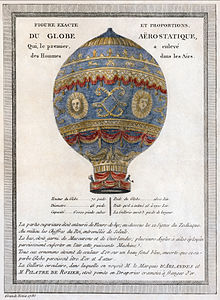History of Flight/Introduction
The dream of being able to fly is likely as old as abstract thought. Our earliest human ancestors looked at birds, majestically spreading their wings and flying high overhead – and dreamed of ways to gain the gift of flight.

Ancient myths and legends offer many examples of the human dream of flying like birds. An ancient Greek legend has King Corinth, with the aid of the winged horse Pegasus, flying into battle with a multi-headed monster. Ancient Persian legend has the King capturing eagles and attaching them to his throne so he can fly around, checking on his kingdom. One of the best-known Greek legends is that of Daedalus and Icarus, a father and son who flew by fashioning wings from wax. Icarus was so intoxicated by the experience that he ignored his father's warning, soared too close to the sun and crashed to earth after his wings melted.
In practical terms, around 400 B.C.E. The Chinese invented the kite. This simple device led them to think that humans might fly aboard a large kite. While that dream proved elusive at the time, the invention of kites was a start on the road to other important flight discoveries such as balloons and gliders.
The history of human flight is primarily one of disappointment until the 18th century. Many brave inventors tried to achieve flight, often by attempting to mimic flying as birds do. Some tried to fly by attaching wings to their arms and jumping from high cliffs, but these episodes of course ended in disaster.
By 1485, Leonardo da Vinci had started sketching his ideas of ways in which people might fly, including his flapping-wing ornithopter. He produced hundreds of flight-related sketches, many of them showing devices to get humans airborne. Da Vinci's air screw has inspired many others since and, while it could never have flown, is often considered an inspiration of the modern helicopter.
The French brothers Joseph-Michel and Jacques-Étienne Montgolfier were the first to get humans airborne, in their hot-air balloon. They made a big bag out of taffeta fabric used a fire underneath to fill the bag with hot air. The passengers climbed into a basket that surrounded the hole at the base of the balloon and, as it filled with hot air (which is less dense than cold) the balloon was able to rise.
Before the king allowed humans to fly, though, the balloon had to be tested. The very first passengers, or test pilots, were three animals. This honor went to a duck, a rooster and a sheep. They flew about two miles at a height of up to 1,500 feet.
In the 19th century, the American brothers Orville and Wilbur Wright tested their flying machine, creatively named Flyer, at Kitty Hawk in North Carolina. Kitty Hawk was chosen because it was reliably windy, which helped get the aeroplane aloft. Later, the Wright brothers opened the first flight school to the public.
The desire to leave the ground and fly freely has captured human imagination for millennia. Now, with flight such an everyday experience, we can easily forget the many brave men who sacrificed so much including, often, their lives in the pursuit of the dream of flight. If it were not for these men's persistence and bravery, we might still be marvelling at the birds' abilities and dreaming of joining them in the skies.